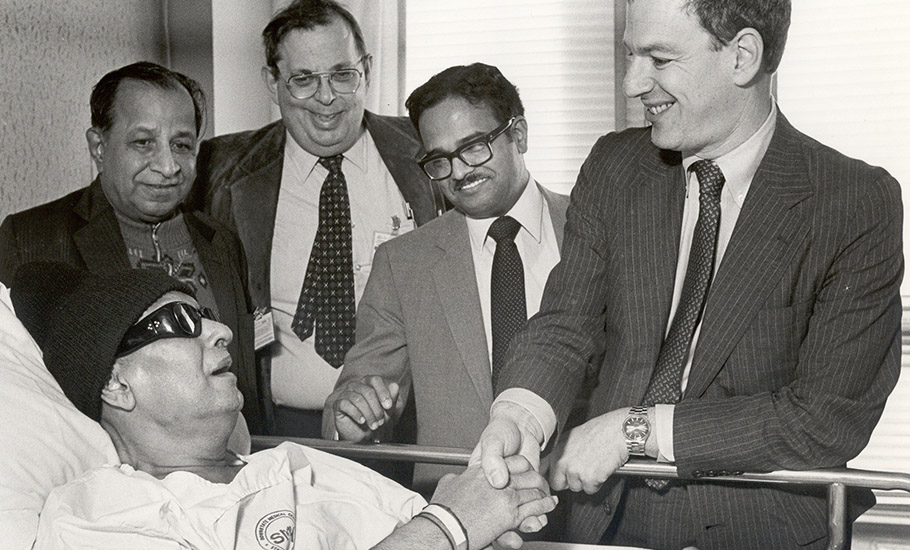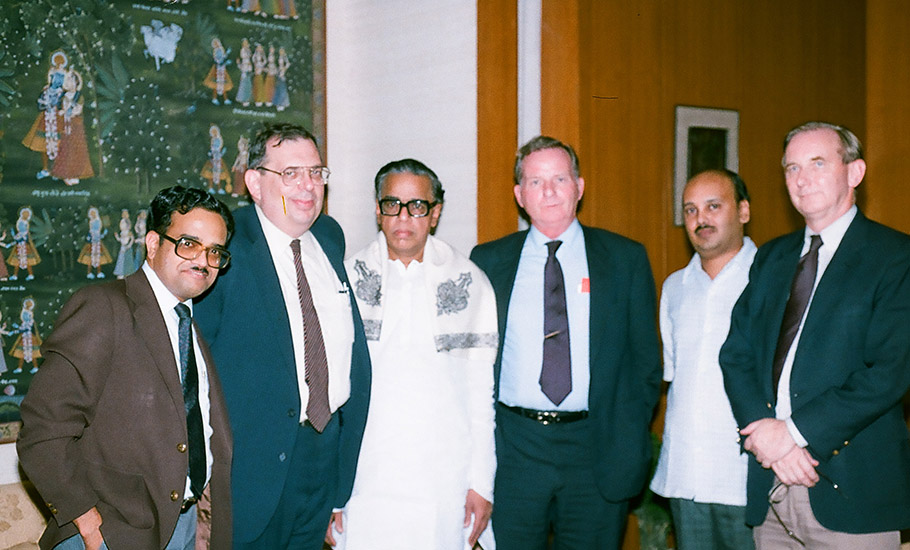
- Home
- News
- Analysis
- States
- Perspective
- Videos
- Education
- Entertainment
- Elections
- World Cup 2023
- Features
- Health
- Business
- Series
- Economy Series
- Earth Day
- Kashmir’s Frozen Turbulence
- India@75
- The legend of Ramjanmabhoomi
- Liberalisation@30
- How to tame a dragon
- Celebrating biodiversity
- Farm Matters
- 50 days of solitude
- Bringing Migrants Home
- Budget 2020
- Jharkhand Votes
- The Federal Investigates
- The Federal Impact
- Vanishing Sand
- Gandhi @ 150
- Andhra Today
- Field report
- Operation Gulmarg
- Pandemic @1 Mn in India
- The Federal Year-End
- The Zero Year
- Premium
- Science
- Brand studio
- Home
- NewsNews
- Analysis
- StatesStates
- PerspectivePerspective
- VideosVideos
- Entertainment
- ElectionsElections
- Sports
- Loading...
Sports - Features
- BusinessBusiness
- Premium
- Loading...
Premium

How Indian, American and Pakistani doctors brought MGR back to life 38 yrs ago

A specially arranged ward at the research wing of the Downstate Medical Center in Brooklyn, New York. Letters from people across the world, mostly from India, offering organs to their leader pouring in. “I am ready to donate my heart, kidney and liver. Take whatever you want, I want you to come back to life,” one of them wrote. The address that many typed on the envelope was...
A specially arranged ward at the research wing of the Downstate Medical Center in Brooklyn, New York. Letters from people across the world, mostly from India, offering organs to their leader pouring in. “I am ready to donate my heart, kidney and liver. Take whatever you want, I want you to come back to life,” one of them wrote. The address that many typed on the envelope was incomplete: “MGR, Chief Minister, Brooklyn, New York”… TK Sreepada Rao, a leading nephrologist at the Downstate Medical Center, was clueless about how hundreds of such letters reached the hospital where matinee idol and the then chief minister of Tamil Nadu MG Ramachandran was admitted for a kidney transplant in 1984.
It has been 38 years. Rao was the chief nephrologist in the four-member team headed by Dr Eli Friedman who flew down to Chennai to treat MGR who was undergoing peritoneal dialysis at Apollo Hospital since October 5, 1984, due to kidney failure and a subsequent stroke which paralysed the right side of his body.
It was midnight when the team reached Delhi from New York. At the airport, the team of doctors from the US was received by the Tamil Nadu health minister HV Hande. Since the next flight to Chennai was available only in the morning, Prime Minister Indira Gandhi, who happened to return to Delhi after visiting MGR the same day, allowed them to use her special aircraft to travel to Chennai. “It was a comfortable trip. I remember Eli Friedman sleeping on the bed that the Prime Minister used while travelling. We landed in Chennai in the early morning on October 17, 1984. We were taken to the hotel where we had a quick shower. At 6 am, we were at the Apollo Hospital,” said Rao.

As a renowned nephrologist, Rao had treated political leader Jayaprakash Narayan and former chief minister of Andhra Pradesh Chenna Reddy other than MGR. But his role in bringing back MGR to life was eventful. Despite giving better care to MGR, Rao also documented the moments of struggles as well as hopes of MGR at Downstate Medical Center where he underwent a kidney transplant. Born in 1943 in Karnataka’s Kolar, Sreepada Rao is a well-known nephrologist in the US. Rao has more than 500 photographs that he had documented while taking care of MGR in India as well as in the US. He is writing a memoir, and it will be out soon.
MGR was lying unconscious on the 6th floor of the Apollo hospital in Chennai. The senior doctors in the hospital, barring Prathap Reddy, were a bit reluctant about the arrival of ‘foreign’ doctors. “We were warned by health minister Hande and other senior ministers that there would be some reluctance from the doctors in the Apollo hospital. It was true. Even though Prathap Reddy was friendly and pleasant, a senior nephrologist in the hospital was not happy with our presence. But there were no issues as we had strong support from the state government,” said Rao.
However, the US doctors were not happy with the way MGR was being treated. “MGR was suffering from diabetes and we don’t recommend a shunt on a diabetic patient. But in MGR’s case, the shunt used during the dialysis was performed on his right leg. We don’t advise this practice at all. We asked them to remove it. When we suggested some alternatives, the doctors were reluctant initially. But they soon followed what we suggested,” he said.

Even though Rao started hemodialysis on MGR, Eli Friedman found the matinee idol was too sick to be shifted anywhere. So he returned, asking Rao to stay back and continue with hemodialysis for a week. The hemodialysis helped. A decision was made soon to take MGR to the US for a kidney transplant.
MGR was semi-comatose when he was brought to the hospital through a chartered Air India flight. Rao himself went to the JFK Airport to receive the team. “I first kept an ambulance ready and then proceeded towards the aircraft. A stretcher-bound MGR was accompanied by his wife VN Janaki, family doctors and others. He was unconscious,” said Rao. A special ward was arranged for MGR at the Downstate Medical Center. MGR didn’t recognise anyone even after three days, so the nurses played his favourite movies using a VCR. “MGR was not aware of what was going on around him. To activate him, we played some of his famous movies in the hospital itself. MGR would only look at the screen intially, but gradually started to show slight improvement due to proper hemodialysis,” said Rao, who lives in New York.
A month in the hospital helped MGR regain consciousness. He started a brisk walk inside the room itself. Eli Friedman put Rao in-charge of everything related to MGR in the hospital. Even though Rao was able to manage the visitors, he couldn’t control the flow of letters to MGR sent by his admirers from various parts of the world. “There were many letters from people around the world offering MGR their organs. Some even wrote letters to their favourite hero soaked in their own blood,” he said.
Finding a donor was not difficult but finding the matching donor was challenging. Leelavathi, daughter of MGR’s elder brother Chakrapani, came forward. But there was a problem. Friedman wanted to know whether she was willing to donate her kidney to her uncle without any coercion. When asked about it, Leelavathi said she badly wanted to do it as Tamil Nadu wanted MGR as ‘he was treated as a god there’. The team decided to perform the transplant on December 12, but there was a small medical issue and it was postponed to December 19. The transplant, done by Khalid Butt of Newyork Medical Centre, a Pakistani surgeon, worked out well and the donor kidney started functioning inside the body of MGR immediately. But Rao kept an eye on MGR, and he didn’t want to take a chance.
Rumours about MGR’s health since he was admitted to the Apollo Hospital in Chennai had an adverse impact on All India Anna Dravida Munnetra Kazhakam’s (AIADMK) prospects. So to assure the public that their leader was alive and healthy, AIADMK leaders wanted to record videos and show them to the people. “Many videos of MGR were shot. The recorded videos were screened in various parts of Tamil Nadu, as the election to the assembly was round the corner. MGR had so many visitors those days,” said Rao.
The AIADMK won the assembly election held on December 24, 1984, mainly due to the sympathy wave since the assassination of Prime Minister Indira Gandhi on October 31, 1984, and the illness of their leader. MGR had established renewed ties with Indira Gandhi soon after his victory against the DMK-Congress alliance in 1980 elections. This was part of the reason why people voted for him after her assassination. His own health led to express their support and sympathy by voting for AIADMK. The party made extensive use of visuals of MGR undergoing treatment and the funeral procession of Indira Gandhi as part of the campaign material. The AIADMK also churned out songs praying for MGR’s well-being.
Meanwhile, he was fit to return.
“MGR was healthy and stable. Eli Friedman said he could return to India. He asked me to accompany him. There was no special flight, but the entire first class of the Air India flight was booked for us. We also arranged a speech therapist to travel with us as MGR was having some issues while talking,” said Rao.
Back home, MGR and the doctors who treated him were given a warm welcome. Rao doesn’t know how many shawls he received, “Many ministers were there to receive MGR. They were worried whether MGR would recognise them or not. But MGR recognised everyone. He waved at them and hugged some of them,” said Rao.

In Chennai, Rao stayed at the Chola Sheraton, but he would go to the Ramavaram Gardens where MGR stayed every day. He did this to ascertain MGR was doing well. One day, Rao was at the Ramavaram Gardens with his family when MGR came out without his fur cap and dark glasses, Rao’s little daughter couldn’t recognise him. “Where is MGR,” she asked. MGR smiled, and held her and said, “I am MGR.”
Later, when MGR toured the US, he visited Rao’s residence. Rao invited all the doctors who had treated MGR during the transplant to his place. Even though he threw a grand party, he avoided liquor because MGR was a known teetotaller. “It was an honour to treat MGR,” said Rao, who is working on a memoir with the photographs that he had taken. “I have digitised all the photographs that I have taken. I will be using those rare pictures in the memoir that I have been writing,” he said.

